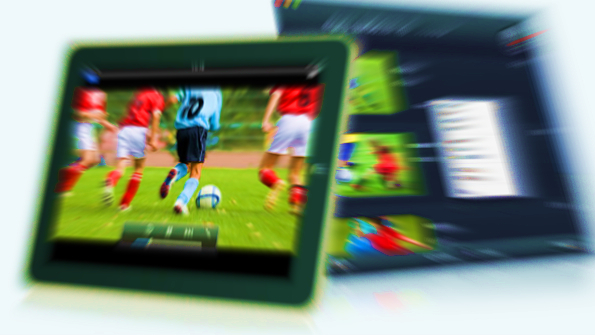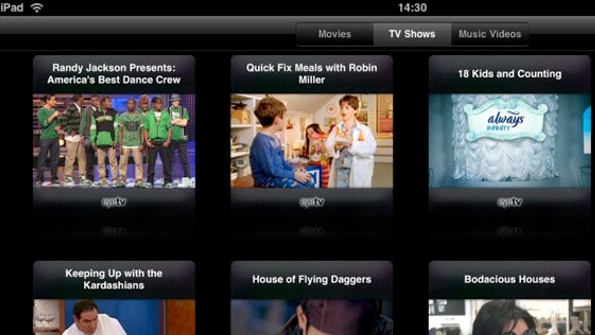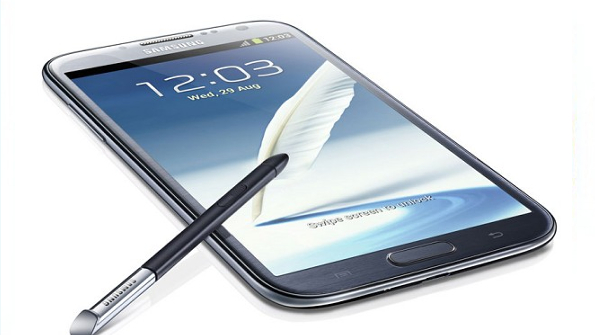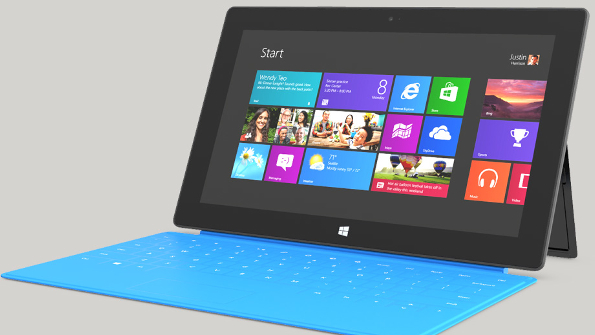Tablet Wars: Google, Apple, Amazon, Microsoft, Samsung and the Race for the Mobile TV Experience

It’s clear that the race is officially on. Now that various tablets have come and gone, as well as steadily been refined, it is becoming clearer who are the major players in this new multi-billion dollar market. What will be interesting is who will be here a year from now and who will not. While content producers are watching, and the public is deciding, some winners will rise to the top and win this new era of mobile entertainment. But who?
It’s first important to realize that mobile TV and portable entertainment is changing and being redefined. When we think of mobile TV the first sense is that we’re watching live TV on a portable device. And that has certainly gained traction this past year on several fronts. The Dyle branding has been slowly seeping into the consumer awareness in limited areas and with limited products, with the mission to show what devices are ready to view live television. Unfortunately, most of the time, a solution involves adding a separate device to a tablet — such as Elgato’s EyeTV involving an external box and antenna. Not the best solution, but certainly workable. The public may not be clamoring for live TV on their devices, but may grow to accept it and spur adoption if the barrier is low enough from an ease and price point. More popular is the option to watch your provider's channels live on your tablet, with companies such as Time Warner and Comcast providing tablet viewing experiences, usually via a user's own wi-fi network. Consumers warm to this experience because flicking through scores of digital channels is akin to what they are used to in their living room. Content producers are happy because they can produce one show to be viewed on many screens and devices. What is mostly missing from the tablet genre is the lack of built-in OTA support. Tablets are rarely constructed with the Dyle-branded hardware to internally and natively pick up local ATSC HDTV signals. The DTV tech is there, and this could be the next killer feature, but so far, even with Dyle’s unbridled enthusiasm and support, it has yet to really take off. What has become most popular is viewing streaming or on-demand content via apps. Netflix and Hulu lead the pack as far as streaming goes, with ecosystems such as Amazon Prime offering thousands of movies and TV shows to stream. Scores of other apps on Apple, Android and Windows offer a wide variety of purchasing video content a la carte. But with so many hardware options, is there one platform that gives a richer experience than others?
Many think Apple started the tablet revolution, and in one sense, that is true. But it's easy to forget that Microsoft was marketing and shipping tablet software incorporated into Windows a full decade before the iPad’s launch. Although tablet-laptop combos were heavy and often clunky to use, we have to give props to MS for at least trying, as well as sticking to its guns. Unfortunately, the combination of a stylus as well as the anchor of the legacy Windows platform, did not make the tablets too nimble. Apple’s success came from rethinking the tablet and heading in the direction we’ve seen in movies for decades, a lightweight touch screen. The key difference, however, is it built a new OS from the ground up, iOS, that was made for portable performance, as well as incorporated chips and batteries designed for a new generations of units. Apple’s head start was also the result of the widely popular iPhone, and the iPad benefitted from a lot of trial and error in the fine-tuning that the iPhone went through. In fact, the first iPhone did not have apps (except for the ones shipped with the phone) or an app store, but instead relied on “web apps,” small web pages designed to run as programs. Fortunately, Apple opened up the development of apps by third parties and the rest is history, launching a brand-new industry of App stores.

Apple has the best ecosystem and also is focused on turning a profit with its hardware. Although other companies sell their tables at a loss to support their ecosystem, or proudce their OS at a loss to make money on devices, Apple is the rare company who is making huge profits from both the hardware and software side of things. And although its marketshare may never be number one, its profits will most likely be. Because of its success, developers gravitate to the iOS platform first, ensuring that most if not all mobile video and TV solutions hit there first, if not exclusively. Apple’s hardware is also highly refined and alluring to the public. The retina screen and yearly processor updates have made video and apps run like clockwork, and the newly introduced iPad mini makes the whole experience even more enticing and portable.

Amazon has tried to keep pace with Apple and has done so with success, or at least it seems so. It’s hard to tell because Amazon’s progress reports to the press have been vague characterizations such as their Kindle tablets are “most requested gifts” or “number one most wanted” or “Kindle sales doubled last week” or any number of other hard-to-pin-down discussion points. Because it doesn't release sales numbers, it is hard to see how good or bad Kindle tablets are doing. Of course it’s a hard sell anytime you stop over to the Amazon website (can’t miss the Kindle ads), but Kindle could be selling in the hundreds or thousands, no one is really sure. We can be sure that Amazon is less centered on profitability, it wants to sell its tables, even at a loss, to get more Amazon content consumption devices out into the wild. It also shipped a less appealing first version of the tablet Kindle (Amazon gets better as it updates its devices) but the newer Kindle HD iterations are much improved and correct many of the points not admired in the past version. Like Apple, Amazon has support of major streaming apps, as well as a vast library of movies and TV for purchase. However, unlike Apple, the company has its own streaming service which it is racing with Netflix to try to sign up content providers for. So far, the focus has worked out well: The Amazon Prime streaming has proved to be robust with mobile video content providers at a relatively low yearly price.

Google has seen wide adoption of its Android platform and is certainly giving Apple’s iOS a run for the money. But as a cohesive infrastructure it tends to cloud the water a bit. The past year or two a stream of Android tablets have entered the marketplace, only to have mostly failed. Each device manufacturer has its own heavily altered version of Android, making cohesion and adaptability a problem for developers and consumers. What has changed is now Google has started shipping its Nexus brand of tablets. These share a lot of the characteristics of other ecosystems, with streaming apps and such, but the biggest benefit is a consistent user experience. If you have one Nexus tablet, your next one is going to be just as easy to use. Also Google has worked to fine tune the Android code so it runs much smoother on its own new tablets. The company has also also upped the resolution on the current ones, giving Apple’s retina display some much needed competition. The only thing holding it back is brand awareness in the marketplace. Although the tech crowd loves the devices, the general public needs to embrace them. Like Amazon, Google is coy with sales figures so we have no idea how it is doing. But the one thing going right is the Android tablet market could end up being less fragmented, as long as the Nexus units take off, and if other vendors develop their version of Android to be more in line with the look and feel of the Nexus line.

Samsung has been the success story that many are watching, and is shaping up to be a prime player in the tablet wars. The key reason is fine-tuned hardware as well as alternate size options. Android-based, the company's Galaxy phones have been selling like hotcakes. And although its larger tablets have not been such as big a hit, the mobile phone company's alternate option, the 5in Galaxy Note II, is a major product to watch. An important demographic, that is mostly being missed by the other vendors, this not quite a phone size and smaller than a tablet could end up being a powerful dynamic in the coming year. It operates great as a phone, but it also works not unlike a tablet, complete with a touch screen built for digits and an included stylus. This middle product works on multiple levels, it functions as a phone, it serves as a tablet, and the screen is big enough for immersive video viewing. All the other companies discussed here don’t seem too focused on this 5- and 5.5in genre; Samsung could corner this market. Its initial Galaxy Note was a hit, and the Galaxy Note II has become an even bigger smash. The convenience and portability of a phone without the bulk of a tablet can and does make for a prime video entertainment experience.
The professional video industry's #1 source for news, trends and product and tech information. Sign up below.

Microsoft has released Windows 8 as well as its own Surface tablet, and it is safe to say the jury is still out. It has hopefully learned from its decade of clunky tablet netbook solutions and has started to pick from the feature sets of competing tablets. Consumer awareness is high, mainly because Microsoft has spent millions blanketing every form of advertising, TV to print, with images of happy people gleefully using their Surface tablets. Where will it be a year from now? Still here. Microsoft is not one to give up easily; however, it's yet to release any sales numbers on its Surface tablets. And, although the hype is there, interest from consumers seems to be thinner. Surface is not particularly innovative, it lacks a software ecosystem on the level of competitors, and its ties to legacy Windows desktops can be a drag. However the Metro interface is fresh and funky, and while the app selectionis admittedly meager — especially for mobile TV — there is hope it will grow over the next several quarters. From a hardware standpoint the Surface is built for viewing, even with its own stand, so it will not be counted out just yet.
Which company and products will win the race for mobile TV tablet? It’s wide open, and there may be multiple winners with a few casualties. Ecosystem is key for consumer acceptance: Ease of use and vast options often win. Apple is leading here, and certainly Amazon is building. In fact, Amazon could almost be labeled as creating “content consumption devices.” Although its design is improving, but perhaps does not have the beauty of Apple’s line, its one-stop shopping (literally) even with a thinner app store, is certainly a compelling option. Amazon’s next step should be an Apple TV-like device, to go full circle, so I am sure that is coming. But for tablets, Amazon is hard to beat for selection of video, as well as compelling tablet prices. Apple is nailing the hardware angle and even with premium prices, the iPad is the one item in the whole wrapup that people mostly want. Microsoft has a long road of catch up to navigate. It would be nice to see it convert its spry and compelling Windows phone software into a tablet with its own iOS. But its love of legacy (Windows) makes that a slim bet. Usability is a key seller, as Apple is the leader here, but Surface requires a learning curve, which could drag adoption. Also Surface needs to get out in public more, good luck trying to find an actual Surface to play around with at Best Buy or Staples. If MS can ramp up its developer network, Mobile TV on Surface could be a compelling option indeed. As for Android, Samsung will continue to advance with delectable hardware options, bigger screens and the 5in market should continue to grow. Google has the tech fans love, but needs to warm up more with mainstream consumers. It is a trusted name, and the dovetail should not be too hard. Taking all into consideration its going to be an interesting 12 months, for content producers as well as companies. As Dyle support ramps up, mobile TV apps become more widespread, and platform and hardware vendors expand their own ecosystem and video streaming libraries, there has never been a better time to take entertainment portable or have your favorite content in the palm of your hand.
